-
FEBRASGO POSITION STATEMENT07-03-2025
Asthma and pregnancy
Revista Brasileira de Ginecologia e Obstetrícia. 2025;47:e-FPS5
Abstract
FEBRASGO POSITION STATEMENTAsthma and pregnancy
Revista Brasileira de Ginecologia e Obstetrícia. 2025;47:e-FPS5
Views14See moreKey points
•Asthma is the most common lung disease during pregnancy and its diagnosis is determined in the same way in pregnant and non-pregnant women.
•Spirometry is a simple test used to confirm and monitor the disease, and has no contraindications for use during pregnancy both in the pre- and post-bronchodilator phase.
•The control of asthma before pregnancy is the main predictor of disease severity during pregnancy. Other predictors of asthma attacks include smoking, overweight and obesity.
•Inadvertent interruption of maintenance medication is one of the factors most associated with exacerbation and complications related to asthma during pregnancy.
•In general, treatment of pregnant women with asthma should be similar to that of non-pregnant women. Inhaled corticosteroids (ICS) are the main medication to achieve and maintain control of the disease during pregnancy.
•Corticosteroids prescribed for maintenance treatment of chronic asthma have no effect on accelerating fetal maturity. The usual protocol should be used when this acceleration is necessary.
•Moderate asthma exacerbation includes at least one of the following criteria: 1) worsening of respiratory symptoms; 2) worsening of lung function; 3) increased use of inhaled pump medication (e.g., salbutamol; at least two-day duration).
•Severe asthma exacerbation includes at least one of the following criteria: 1) use of systemic corticosteroids or increased dose of maintenance oral corticosteroids for at least three days; 2) hospitalization or visit to the emergency room (ER) due to asthma requiring the use of systemic corticosteroids.
•Asthma does not normally affect labor or the choice of delivery route.

-
Original Article06-09-2025
Epidemiological profile of breast cancer in a reference center in the north region of Brazil
Revista Brasileira de Ginecologia e Obstetrícia. 2025;47:e-rbgo27
Abstract
Original ArticleEpidemiological profile of breast cancer in a reference center in the north region of Brazil
Revista Brasileira de Ginecologia e Obstetrícia. 2025;47:e-rbgo27
Views131See moreAbstract
Objective:
To describe the epidemiological data of women with breast cancer at a referral center in oncology in the northern region of Brazil.
Methods:
This is a retrospective cohort study. The study population consists of patients who were diagnosed with in situ or invasive BC (invasive carcinoma of no special type (ICNST) and invasive lobular carcinoma (ILC)) at the Hospital de Amor da Amazônia, in Porto Velho – Rondônia, between January 2012 and December 2021. The sampling plan adopted was of the convenience type. All patients who received the anatomopathological diagnosis of in situ or invasive BC at the Hospital de Amor da Amazônia from 2012 to 2021 and came from the North region were included. Exclusion criteria were non-origin from the North region and absence of diagnosis established by anatomopathological examination of breast cancer. Analysis of the database and medical records of the Hospital de Amor da Amazônia was carried out to collect information.
Results:
420 patients were included, 99.5% female, with complete elementary school (32,6%) and brown skin (68,1%). The mean age at diagnosis was 49 years. Forty-five percent were born in the northern region and 55% in other regions of Brazil. Eighty percent of tumors were invasive ductal carcinoma; 32.7% were luminal A-like, 25.1% luminal B-like, 19.4% HER2 enriched and 12.8% triple negative. When patients were subdivided by age ≤40 years and > 40 years, there was a statistically significant difference in the association with staging (p=0.000), histological type (p= 0.035), immunohistochemistry subtype (p=0.000), neoadjuvant chemotherapy (p=.000) and genetic counseling (p=0.001). The median survival was 7.99 years. The 5-year overall survival was 81%. The higher the stage, the lower the survival rate. Twenty-four distinct variants were described in patients undergoing genetic testing, 16 of uncertain significance and 8 pathogenic. Three new variants were described: ATM (c.8726G>C), BRCA2 (c.2232A>C) and ERCC5 (c.2164G>Ap).
Conclusion:
In this study, the age at diagnosis of breast cancer was lower, the tumor subtype was more aggressive, and patients were admitted in more advanced stages. Overall survival is lower compared to national and international data. Despite the small number of patients referred to genetic testing, it is important to search for germline mutations to improve patients’ diagnosis and treatment.
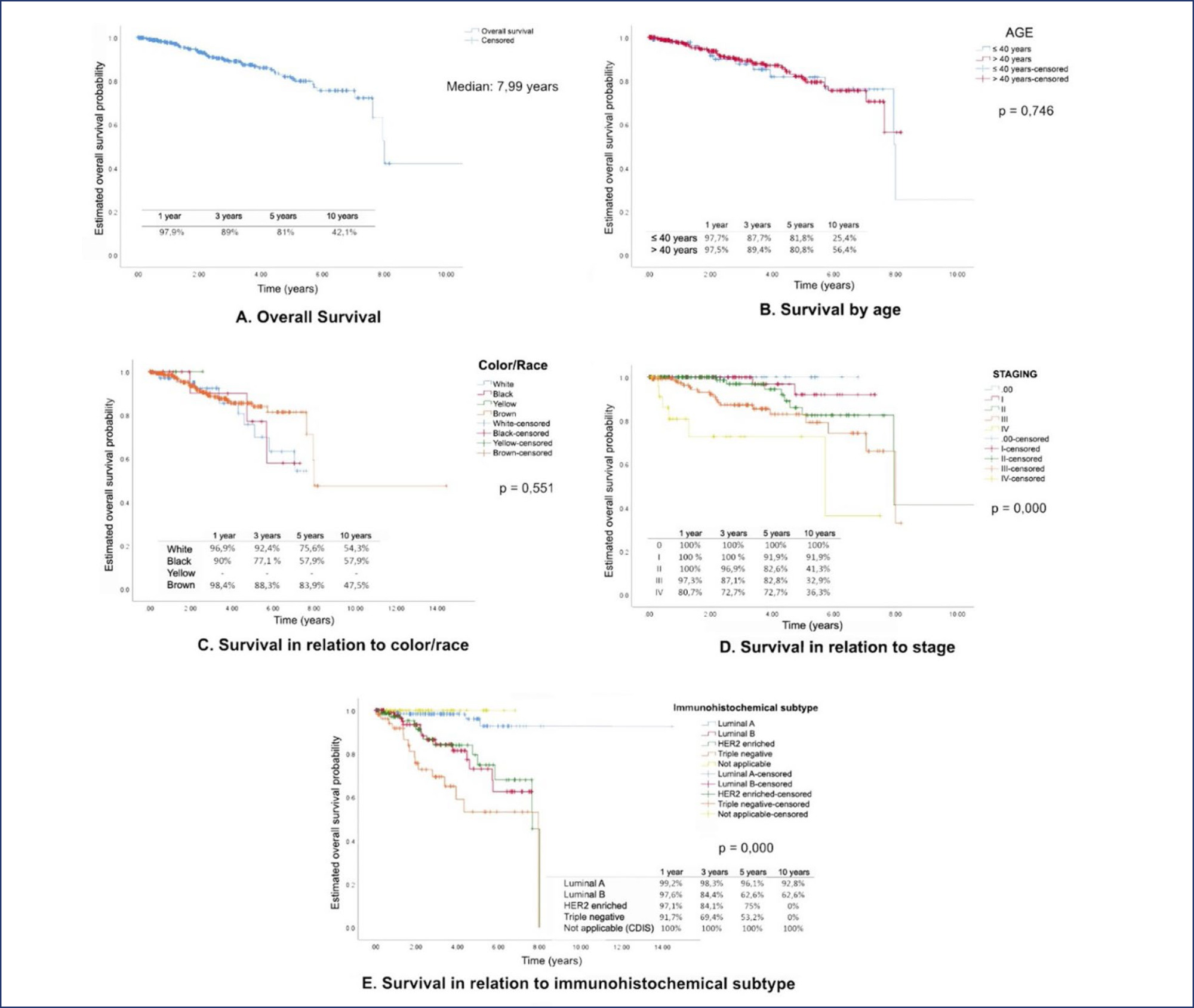
-
Original Article06-09-2025
Evaluation of chronic radiation proctitis in patients with cervical cancer treated with pelvic radiotherapy: a cross-sectional study
Revista Brasileira de Ginecologia e Obstetrícia. 2025;47:e-rbgo26
Abstract
Original ArticleEvaluation of chronic radiation proctitis in patients with cervical cancer treated with pelvic radiotherapy: a cross-sectional study
Revista Brasileira de Ginecologia e Obstetrícia. 2025;47:e-rbgo26
Views117See moreAbstract
Objective:
A combination of chemotherapy and pelvic radiotherapy is recommended to treat locally advanced cervical cancer (CC), which has been associated with acute and chronic toxicities, especially radiation proctitis (RP). The objective of this study was to evaluate the frequency of RP and treatment management in females with CC who underwent pelvic radiotherapy at an oncology referral hospital.
Methods:
This cross-sectional study analyzed the medical records of patients treated with radiotherapy for CC between 2015–2017. We assessed sociodemographic, lifestyle, cancer, treatment, and clinical variables. We identified 298 records of females with CC who underwent pelvic radiotherapy during the defined period. Of these, 14 records were duplicates, 25 were excluded for lacking essential information, and 33 were missing in the archive. Accordingly, 226 relevant medical records were analyzed, with data regarding sociodemographic, clinical, cancer-related, treatment-related, and RP-related variables collected. Pearson’s chi-square test was used to compare symptomatic and non-symptomatic patients. Fisher’s exact test was used to compare chemotherapy doses. Statistical analysis was performed with Stata V12.1. A P-value less than 0.05 was considered significant.
Results:
The median patient age was 48 years (interquartile range 38–61). Patients predominantly had CC stages IIB and IIIB (>70%). Of the 226 females analyzed, 87(38.5%) experienced RP symptoms, represented by rectal bleeding; of these, 59 underwent colonoscopy, confirming RP in 58(98.3%). Accordingly, of the 226 females analyzed, 58(25.7%) had a confirmed diagnosis of RP. There was a statistically significant association between rectal bleeding and cumulative radiation dose (P < 0.001) and the presence of systemic arterial hypertension (P = 0.036). Regarding treatment, 38(65.5%) participants underwent argon plasma coagulation (APC), and of these, 22(57.9%) had no post-treatment macroscopic bleeding.
Conclusion:
Patients with CC who received radiotherapy at an oncology referral service had a high frequency of RP, and APC helped control bleeding in certain patients.
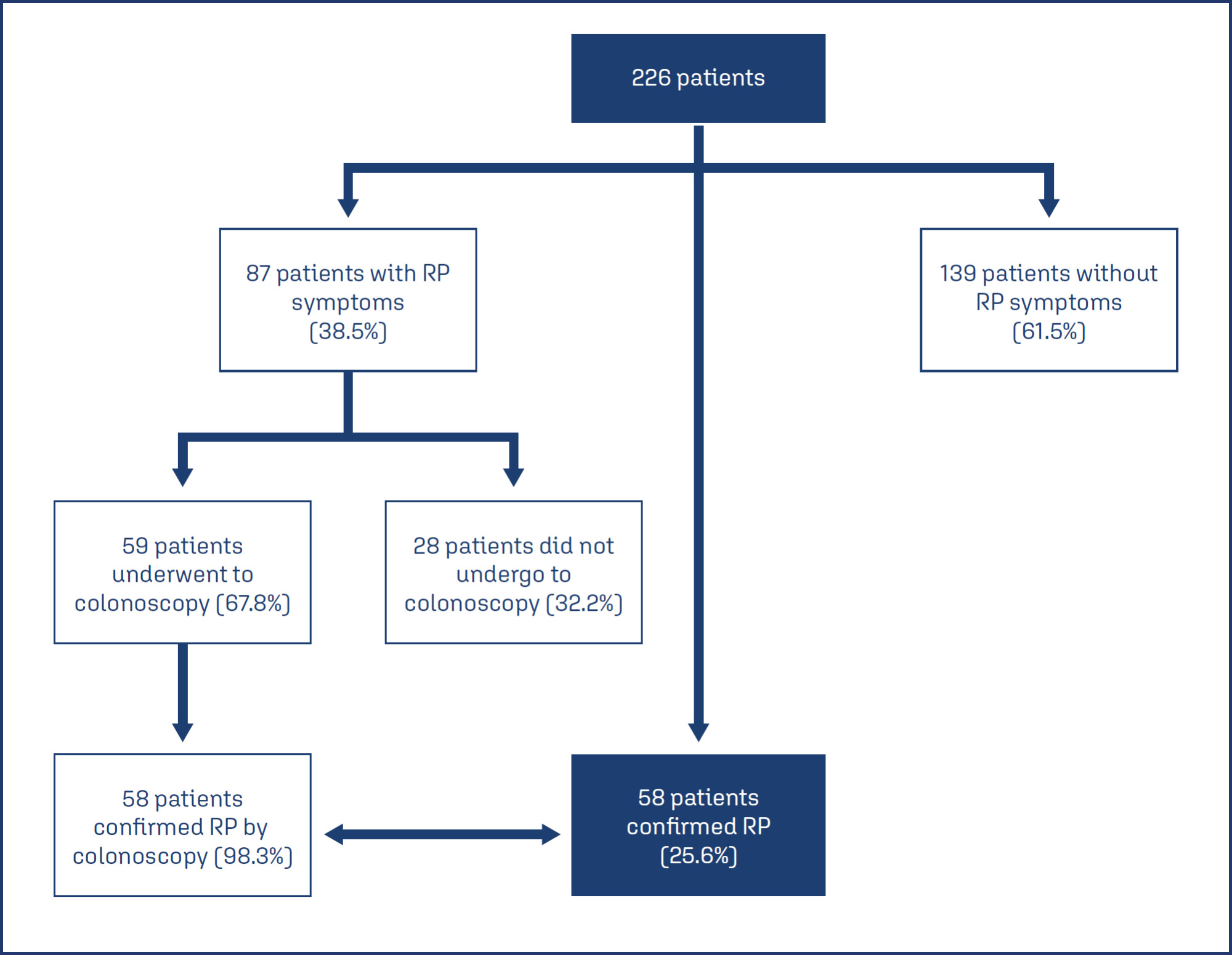
-
Original Article06-09-2025
Impact of the Zero Maternal Death by Hemorrhage Strategy on health professionals’ self-perceived knowledge in managing postpartum hemorrhage
Revista Brasileira de Ginecologia e Obstetrícia. 2025;47:e-rbgo25
Abstract
Original ArticleImpact of the Zero Maternal Death by Hemorrhage Strategy on health professionals’ self-perceived knowledge in managing postpartum hemorrhage
Revista Brasileira de Ginecologia e Obstetrícia. 2025;47:e-rbgo25
Views119Abstract
Objective:
This study aimed to evaluate the results of the Obstetric Hemorrhage Prevention and Management Course – Zero Maternal Death by Hemorrhage Strategy (0MMxH) among healthcare professionals before and after participation.
Methods:
A quasi-experimental design was employed, assessing the educational intervention in a convenience sample of healthcare professionals who had participated in the 0MMxH at least one year prior. Participants completed a retrospective pre-post questionnaire sent via email, focusing on self-perceived knowledge levels and the adoption of best practices in postpartum hemorrhage (PPH) management.
Results:
Out of 129 professionals who completed the 0MMxH training, 85 (65.9%) responded to the questionnaire. The percentages of respondents reporting no or low knowledge before and after the course were: shock index (52.8% to 0%, before and after, respectively), blood loss estimation (35.2% to 1.1%), care sequence for PPH (44.6% to 0%), rational use of crystalloids (37.5% to 1.1%), non-pneumatic anti-shock garment (83.5% to 3.4%), and damage control surgery (74.1% to 8.1%). These results indicate a significant improvement in self-perceived knowledge. After the course, the highest adoption rates of best practices were for shock index (83.5%), blood loss estimation (67.1%), and use of warm crystalloids (58.8%). However, gaps remained regarding non-pharmacological interventions for PPH management.
Conclusion:
Participants reported improved knowledge on most topics covered by the 0MMxH. The program was recognized as a crucial factor in adopting effective PPH management practices, underscoring the importance of training in enhancing obstetric care.
Key-words Health strategiesHealthcare professionalsMaternal mortalityMedical EducationPostpartum hemorrhageSee more -
Review Article06-09-2025
Prophylactic internal iliac artery balloon occlusion in the management of placenta accreta spectrum disorders: a meta-analysis
Revista Brasileira de Ginecologia e Obstetrícia. 2025;47:e-rbgo19
Abstract
Review ArticleProphylactic internal iliac artery balloon occlusion in the management of placenta accreta spectrum disorders: a meta-analysis
Revista Brasileira de Ginecologia e Obstetrícia. 2025;47:e-rbgo19
Views116See moreAbstract
Objective:
Placenta accreta spectrum (PAS) describes the failure of placental detachment. PAS is a pregnancy-associated life-threatening condition which increases hemorrhage risk. We evaluated safety and efficacy of internal iliac artery balloon occlusion (IIABOC) on bleeding volume among pregnant women with diagnosis or suspicion of PAS.
Data source:
We searched PubMed, Embase and Cochrane databases.
Study selection:
Randomized controlled trials (RCTs) and observational studies comparing the efficacy of preoperative prophylactic balloon catheters to a control group with standard care in patients with a prenatal screening of PAS.
Data collect:
We computed odds ratio (OR) for binary endpoints and mean difference (MD) for continuous endpoints, with 95% confidence intervals (CIs). We performed random effects models and assessed I2 heterogeneity statistics.
Data synthesis:
Twenty-four studies were included, of whom 1,023 (51%) received balloons and 983 (49%) did not undergo balloon management. Patients receiving IIABOC had a greater decrease in estimated blood loss (MD −0.33; 95% CI −0.55, 0.11) and increase in operation time (MD 17.21; 95% CI 3.43, 30.99). Apgar score at fifth minute (MD −0.22; 95% CI −0.36,−0.07) significantly decreased. There were no significant differences between groups regarding hysterectomy rates (OR 1.35; 95% CI 0.88, 2.09) and maternal intensive care unit admission (OR 0.81; 95% CI 0.51,1.29).
Conclusion:
While IIABOC have demonstrated a significant reduction in estimated blood loss, these findings have not been consistently replicated in RCTs and the surgeon’s level of experience must be taken into account since it biases the analysis.
-
FEBRASGO POSITION STATEMENT05-16-2025
Mayer-Rokitansky-Kuster-Hauser syndrome
Revista Brasileira de Ginecologia e Obstetrícia. 2025;47:e-FPS4
Abstract
FEBRASGO POSITION STATEMENTMayer-Rokitansky-Kuster-Hauser syndrome
Revista Brasileira de Ginecologia e Obstetrícia. 2025;47:e-FPS4
Views232See moreKey points
•Mayer-Rokitansky-Kuster-Hauser syndrome (MRKH) is the leading cause of vaginal agenesis.
•It is characterized by primary amenorrhea with typical adrenarche and telarche and may be associated with congenital urological and skeletal conditions that should be investigated.
•Differential diagnoses include: vaginal obstructions (imperforate hymen, distal vaginal atresia, transverse vaginal septum), uterine obstructions (cervical atresia), and differences in sexual development (gonadal dysgenesis, complete androgen insensitivity and congenital adrenal hyperplasia due to CYP17 deficiency).
•Laboratory tests (testosterone, follicle-stimulating hormone [FSH] and karyotype) and radiological tests (pelvic ultrasound and MRI) are necessary.
•Vaginal dilation is the first line of treatment with high success rates.
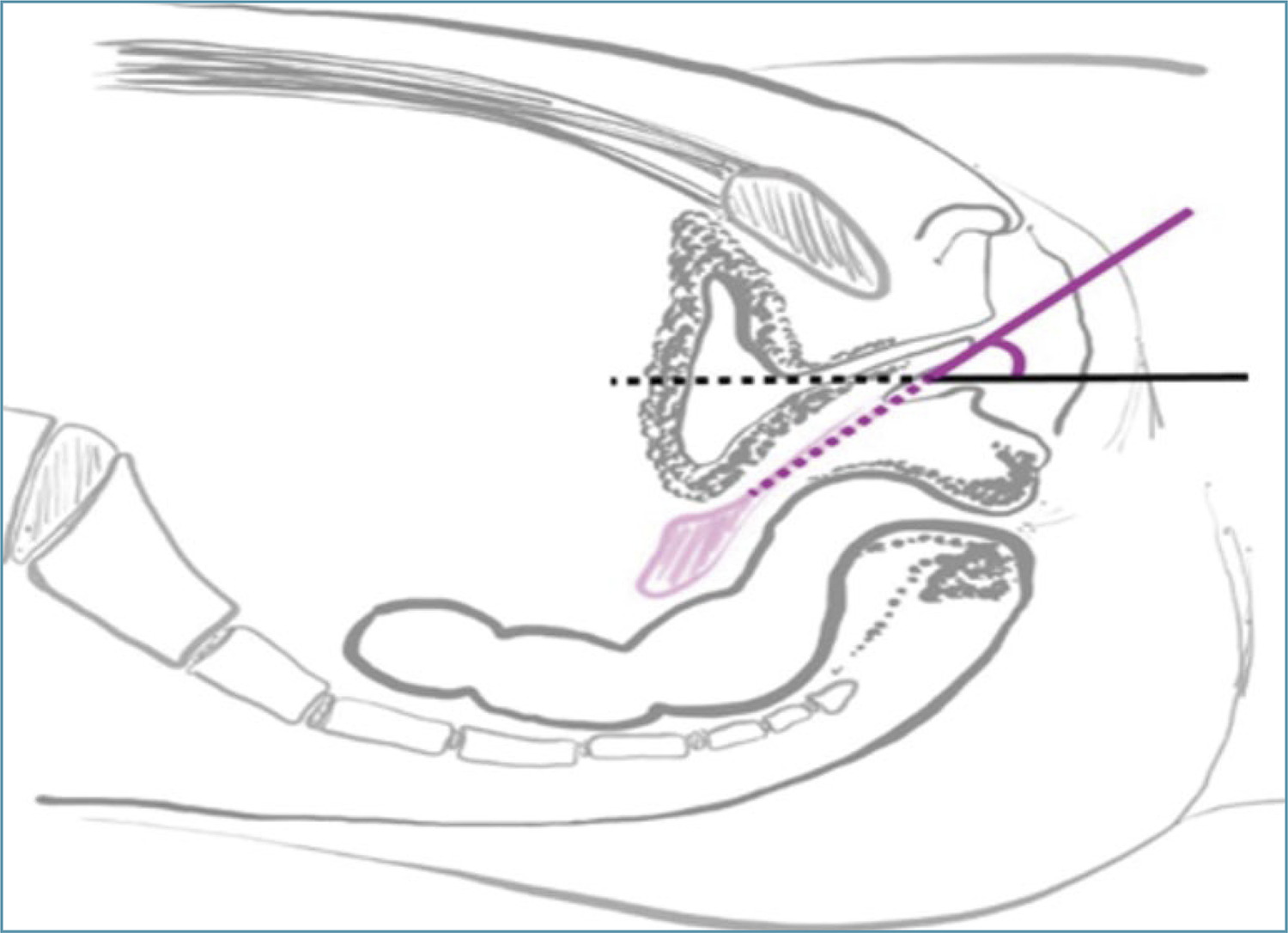
-
Original Article04-30-2025
Hysterectomy rates per resident in final year of training in teaching hospitals: an ecologic study
Revista Brasileira de Ginecologia e Obstetrícia. 2025;47:e-rbgo24
Abstract
Original ArticleHysterectomy rates per resident in final year of training in teaching hospitals: an ecologic study
Revista Brasileira de Ginecologia e Obstetrícia. 2025;47:e-rbgo24
Views240Abstract
Objective:
Analyze the hysterectomy rates per resident in graduation year in teaching hospitals in the state of São Paulo (Brazil).
Methods:
We selected teaching hospitals in the state of São Paulo and gathered information from two public databases to estimate the hysterectomy rates per resident in their final year of training between 2009 and 2019.
Results:
Between 2009 and 2019, there was a 37.5% increase in the number of residents in their final year of training, a 4.31% increase in the number of hysterectomies, and a drop in the hysterectomy rates per resident of 24.1%. The reduction of the rate of hysterectomy per resident was more pronounced for vaginal route (46.4%) followed by abdominal route (23.3%). The ratio of laparoscopic hysterectomy per resident increased 264% during the period, however, this route was used in only 7% of the surgeries in 2019.
Conclusions:
The hysterectomy rates per resident in their final year of training showed a notable reduction. This trend, particularly pronounced in vaginal and abdominal routes, signals a shift towards minimally invasive techniques.
Key-words Clinical competenceEducation, medicalHospitals, teachingHysterectomylearning curveMedical staff, hospitalPhysiciansStudents, medicalSurgical procedures, operativeSee more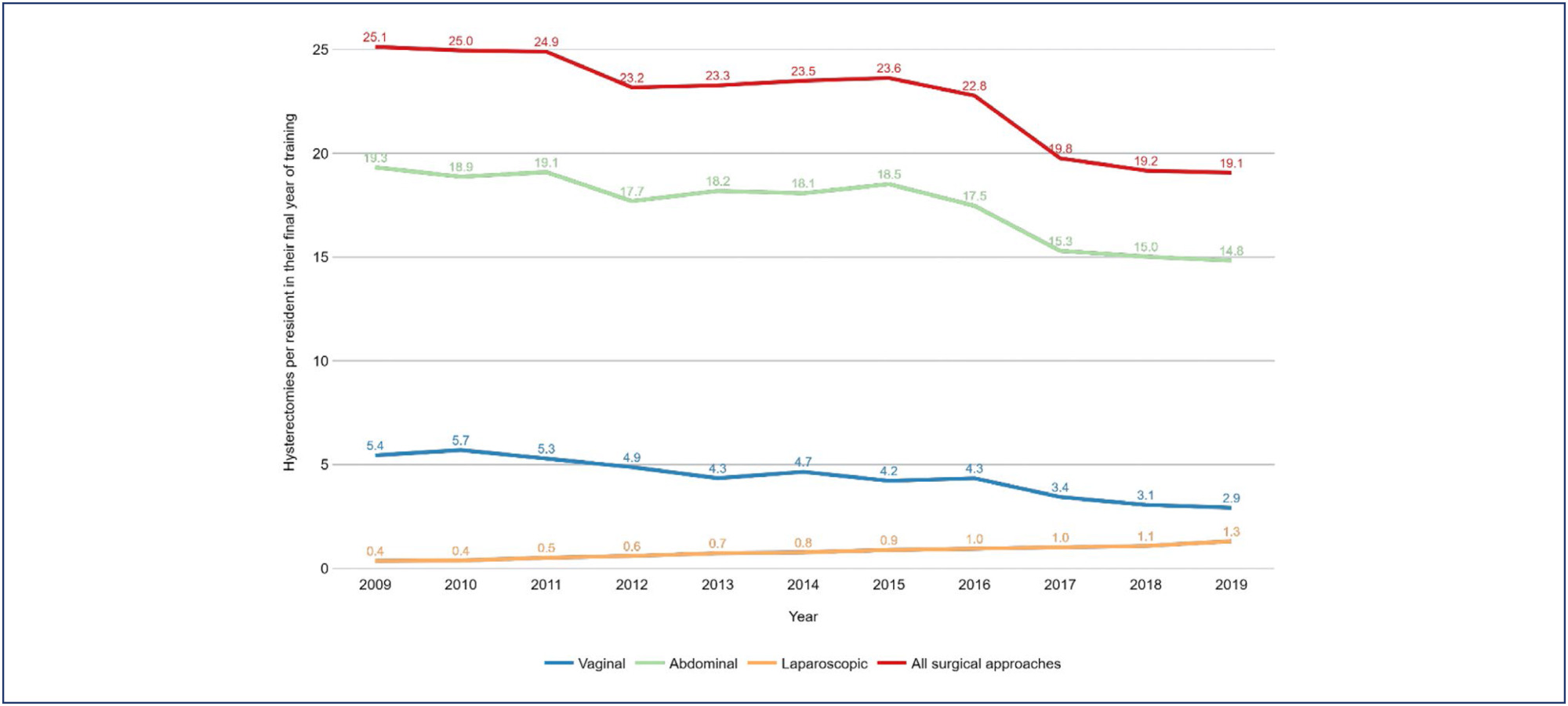
-
Original Article04-30-2025
Prevalence of antiphospholipid syndrome among women with recurrent pregnancy loss: a cohort study
Revista Brasileira de Ginecologia e Obstetrícia. 2025;47:e-rbgo23
Abstract
Original ArticlePrevalence of antiphospholipid syndrome among women with recurrent pregnancy loss: a cohort study
Revista Brasileira de Ginecologia e Obstetrícia. 2025;47:e-rbgo23
Views246Abstract
Objective:
This study aimed to evaluate the prevalence of antiphospholipid syndrome (APS) among women experiencing recurrent pregnancy loss (RPL).
Methods:
A cross-sectional was conducted, reviewing the medical records of 134 women with a history of two or more miscarriages, treated between January 2014 and May 2024 at a tertiary university center in Belo Horizonte, Brazil. APS screening was performed by assessing anticardiolipin (IgG and IgM), lupus anticoagulant, and anti-β2-glycoprotein-1 (IgG and IgM) antibodies, based on Sapporo criteria. All tests were performed during non-pregnant periods and at least 12 weeks after the last miscarriage.
Results:
The study included 134 women with a mean age of 33.8 ± 5.7 years. The number of prior miscarriages ranged from 2 to 11 per couple. Among the patients who presented the lupus anticoagulant, only two (1.49%) tested positive in two samples, as per revised Sapporo criteria. Considering IgG and IgM anticardiolipin antibodies, four patients (2.98%) tested positive in two samples according to old Sapporo criteria, with one patient having a positive IgG test in two samples, two having positive IgM in two samples and a single patient having both positive tests. None of the 56 patients tested positive for anti-β2-glycoprotein-1 antibodies in two samples.
Conclusion:
The prevalence of antiphospholipid antibodies, in line with revised Sapporo criteria, is low among Brazilian women with recurrent pregnancy loss, consistent with recent studies in literature. Ensuring the appropriateness of diagnostic criteria is crucial to avoid unnecessary treatment with platelet anticoagulants and heparin in this population.
Key-words Abortion, habitualAbortion, spontaneousAntibodiesAnticardiolipinAntiphospholipid syndromePrevalenceThrombophiliaSee more
-
Editorial06-06-2013
Endometrial polyps: still exeresis for all of them?
Revista Brasileira de Ginecologia e Obstetrícia. 2013;35(4):146-147
Abstract
EditorialEndometrial polyps: still exeresis for all of them?
Revista Brasileira de Ginecologia e Obstetrícia. 2013;35(4):146-147
-
Editorial01-01-2015
Primary and secondary prevention of metabolic and cardiovascular comorbidities in women with polycystic ovary syndrome
Revista Brasileira de Ginecologia e Obstetrícia. 2015;37(1):01-04
Abstract
EditorialPrimary and secondary prevention of metabolic and cardiovascular comorbidities in women with polycystic ovary syndrome
Revista Brasileira de Ginecologia e Obstetrícia. 2015;37(1):01-04
DOI 10.1590/SO100-720320140005212
Views90Current concepts on polycystic ovary syndromePolycystic ovary syndrome (PCOS) is a very common endocrine disease, affecting women of reproductive age. The prevalence of PCOS varies according to the diagnostic criteria used, with estimates ranging from 9% in women of reproductive age according to NIH criteria up to 18% with Rotterdam criteria , .Evidence indicates PCOS […]See more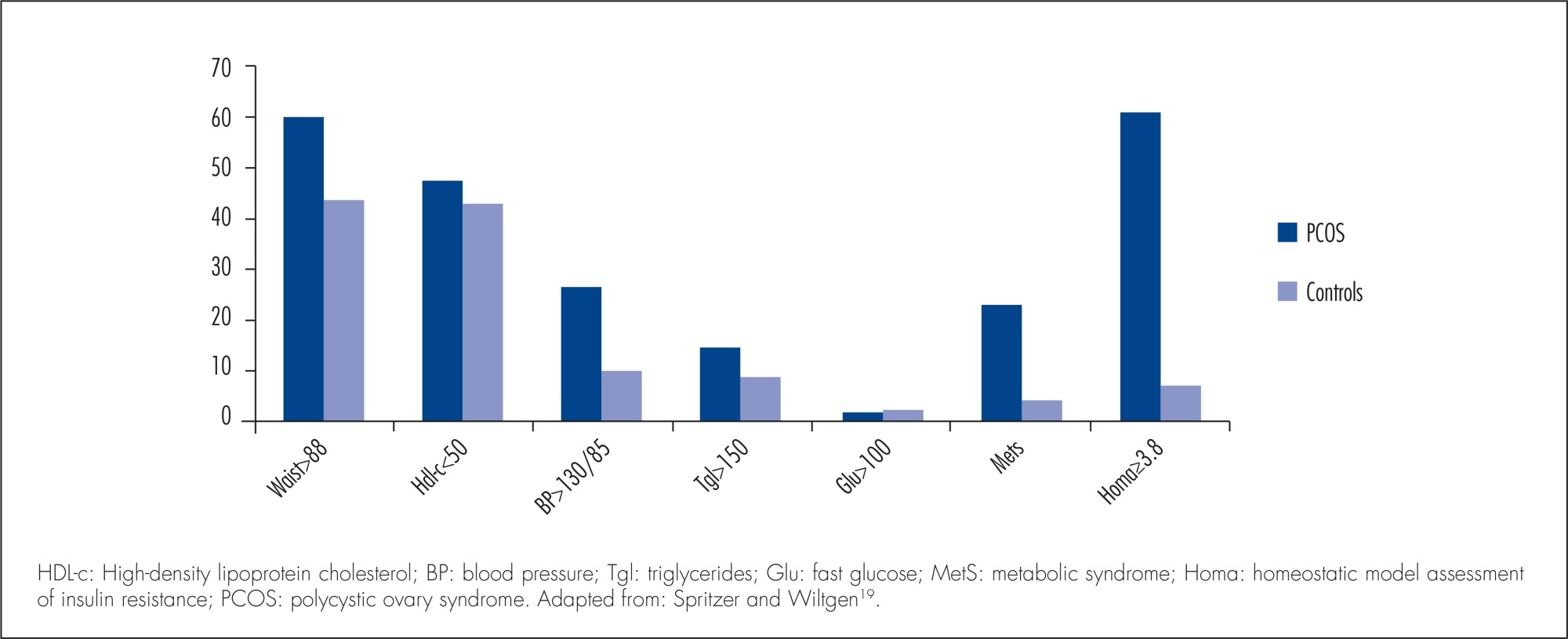
-
07-01-2001
Curva de Normalidade da Área de Secção Transversa do Cordão Umbilical Aferida pela Ultra-Sonografia e sua Correlação com Parâmetros Antropométricos em Gestações Normais
Revista Brasileira de Ginecologia e Obstetrícia. 2001;23(10):675-675
Abstract
Curva de Normalidade da Área de Secção Transversa do Cordão Umbilical Aferida pela Ultra-Sonografia e sua Correlação com Parâmetros Antropométricos em Gestações Normais
Revista Brasileira de Ginecologia e Obstetrícia. 2001;23(10):675-675
DOI 10.1590/S0100-72032001001000012
Views93Curva de Normalidade da Área de Secção Transversa do Cordão Umbilical Aferida pela Ultra-Sonografia e sua Correlação com Parâmetros Antropométricos em Gestações Normais […]See more -
Original Article07-02-2008
Umbilical endometriosis without previous pelvic surgery
Revista Brasileira de Ginecologia e Obstetrícia. 2008;30(4):167-170
Abstract
Original ArticleUmbilical endometriosis without previous pelvic surgery
Revista Brasileira de Ginecologia e Obstetrícia. 2008;30(4):167-170
DOI 10.1590/S0100-72032008000400002
Views93See morePURPOSE: to present a series of cases of umbilical endometriosis in patients in reproductive age, with no previous pelvic surgery. METHODS: four patients aged between 33 and 43 years were included in the study. They all presented umbilical bleeding associated or not with pelvic pain, and medical history varied from two months to four years. Abdominal wall ultrasound was performed for diagnosis support before surgical excision of the umbilical lesions, and histological examination was also performed. RESULTS: the ultrasonographic evaluation of the four patients showed hypoechogenic umbilical lesion suggestive of endometriosis. All patients were submitted to surgical excision and histological examination of the lesions. CA-125 serum levels were measured in three of the patients, but they were within normal ranges (from 6.8 to 10.1 U/mL). In addition to umbilical surgery, laparoscopy was performed in all patients, but only one presented concomitant pelvic endometriosis. In a one-year follow-up, patients maintained asymptomatic and there was no recurrence of the lesions. CONCLUSIONS: umbilical endometriosis is a rare entity, but it may be remembered as a possibility in cases of umbilical nodulations or bleeding, even if there is no previous history of pelvic surgery with endometrial manipulation. Its treatment is always surgical and, in general, it is enough to promote complete elimination of the lesion and of the symptoms.
-
Review Article11-19-2009
Antenatal fetal surveillance
Revista Brasileira de Ginecologia e Obstetrícia. 2009;31(10):513-526
Abstract
Review ArticleAntenatal fetal surveillance
Revista Brasileira de Ginecologia e Obstetrícia. 2009;31(10):513-526
DOI 10.1590/S0100-72032009001000008
Views88The present context of medical practice demands from the obstetrician and gynecologist broad understanding of the scientific and technological advances of the area. The main purpose of prenatal evaluation is to identify fetuses at risk for adverse events or death, for preventive action to avoid mishappenings. The determination of fetal biophysical profile reaches its maximum efficiency when applied within the clinical context of each case. In high risk gestations, the Doppler velocimetry of the umbilical artery has shown to be useful to improve perinatal outcome. In the fetal growth deficit, due to severe placentary insufficiency, Doppler velocimetry of the venous duct has been showing to be an important tool in handling of the cases before the 34th week of gestation. Although no test itself is considered the best to evaluate the fetus’s prenatal vitality, the joint analysis of all methods may lead to a better understanding of the fetal response to hypoxia.
Key-words Echocardiography, dopplerFetal distressFetal hypoxiaFetal monitoringHeart rate, fetalUltrasonographySee more -
Original Article10-30-2009
Electrical stimulation of the pelvic floor versus vaginal cone therapy for the treatment of stress urinary incontinence
Revista Brasileira de Ginecologia e Obstetrícia. 2009;31(9):447-452
Abstract
Original ArticleElectrical stimulation of the pelvic floor versus vaginal cone therapy for the treatment of stress urinary incontinence
Revista Brasileira de Ginecologia e Obstetrícia. 2009;31(9):447-452
DOI 10.1590/S0100-72032009000900005
Views98PURPOSE: to compare the effects of functional electrostimulation of the pelvic floor and therapy with cones in women with stress urinary incontinence (SUI). METHODS: randomized clinical study for which 45 patients with SUI were selected. The effects of functional electrostimulation of the pelvic floor were evaluated in the SUI treatment of 24 women, with the use of clinical data (micturition diary, pad test and a questionnaire about quality of life – I-QoL). The patients were submitted to two 20′ weekly sessions for four consecutive months, under the supervision of a physiotherapist. The electrode used had 10 cm length and 3.5 cm width with a double metallic ring and a cylindrical shape, positioned in the medium third of the vagina. The electric parameters used were: intensity varying from 10 to 100 mA and 50 Hz of fixed frequency, with pulse duration of 1 ms. Also, we evaluated 21 patients who were submitted to vaginal cone treatment. The cone therapy was done with two 45 minute sessions per week. The cones’ weight varied from 20 to 100 gr. RESULTS: there was no difference between the outcomes of electrostimulation of the pelvic floor and the vaginal cones for the treatment of SUI (p>0.05). After four months, there was a significant improvement in the I-QoL index of the patients treated both with electrostimulation (40.3 versus 82.9) or with the cones (47.7 versus 84.1). There was a significant decrease in pad weight in both groups, measured before and after the treatment (28.5 and 32 g versus 2.0 and 3.0 g for the electrostimulation and cone group, respectively). Finally, there was a significant decrease in the number of urinary leakage evaluated by the micturition diary in both groups (p<0.0001). CONCLUSIONS: both electrostimulation and vaginal cones were effective in the treatment of women with SUI.
Key-words Electric stimulation therapyExercise therapyQuality of life, Pelvic floorUrinary incontinence, stressSee more -
Editorial12-08-2011
Gestational diabetes, what did change in the criteria for diagnosis?
Revista Brasileira de Ginecologia e Obstetrícia. 2011;33(8):171-173
Abstract
EditorialGestational diabetes, what did change in the criteria for diagnosis?
Revista Brasileira de Ginecologia e Obstetrícia. 2011;33(8):171-173
-
Original Article07-13-2012
Deep infiltrating endometriosis: anatomical distribution and surgical treatment
Revista Brasileira de Ginecologia e Obstetrícia. 2012;34(6):278-284
Abstract
Original ArticleDeep infiltrating endometriosis: anatomical distribution and surgical treatment
Revista Brasileira de Ginecologia e Obstetrícia. 2012;34(6):278-284
DOI 10.1590/S0100-72032012000600007
Views89PURPOSE: To evaluate the anatomical distribution of deep infiltrating endometriosis (DIE) lesions in a sample of women from the South of Brazil. METHODS: A prospective study was conducted on women undergoing surgical treatment for DIE from January 2010 to January 2012. The lesions were classified according to eight main locations, from least serious to worst: round ligament, anterior uterine serosa/vesicouterine peitoneal reflection, utero-sacral ligament, retrocervical area, vagina, bladder, intestine, ureter. The number and location of the DIE lesions were studied for each patient according to the above-mentioned criteria and also according to uni- or multifocality. The statistical analysis was performed using Statistica version 8.0. The values p<0.05 were considered statistically significant. RESULTS: During the study period, a total of 143 women presented 577 DIE lesions: uterosacral ligament (n=239; 41.4%), retrocervical (n=91; 15.7%), vagina (n=50; 8.7%), round ligament (n=50; 8,7%), vesico-uterine septum (n=41; 7.1%), bladder (n=12; 2.1%), and intestine (n=83; 14.4%), ureter (n=11; 1.9%). Multifocal disease was observed in the majority of patients (p<0.0001), and the mean number of DIE lesions per patient was 4. Ovarian endometrioma was present in 57 women (39.9%). Sixty-five patients (45.4%) presented intestinal infiltration on histological examination. A total of 83 DIE intestinal lesions were distributed as follows: appendix (n=7), cecum (n=1) and rectosigmoid (n=75). The mean number of intestinal lesions per patient was 1.3. CONCLUSIONS: DIE has a multifocal pattern of distribution, a fact of fundamental importance for the definition of the complete surgical treatment of the disease.
Key-words EndometriosisLaparoscopySee more
Search
Search in:
Tag Cloud
Pregnancy (252)Breast neoplasms (104)Pregnancy complications (104)Risk factors (103)Menopause (88)Ultrasonography (83)Cesarean section (78)Prenatal care (71)Endometriosis (70)Obesity (61)Infertility (57)Quality of life (55)prenatal diagnosis (51)Women's health (48)Maternal mortality (46)Postpartum period (46)Pregnant women (45)Breast (44)Prevalence (43)Uterine cervical neoplasms (43)


